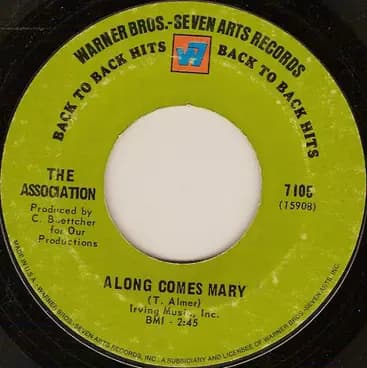
The Association – “Along Comes Mary”: A Psychedelic Pop Gem of the 1960s
Released in 1966, “Along Comes Mary” by The Association is a quintessential piece of 1960s pop music, capturing the era’s experimental spirit with its vibrant, layered sound and cryptic lyrics. The song marked a significant milestone for the band, propelling them into the spotlight as one of the most successful pop-rock groups of the decade. With its upbeat tempo, lush harmonies, and mysterious lyrical content, “Along Comes Mary” stands as a defining example of the psychedelic pop genre that flourished during the mid-60s.
Written by Tandyn Almer, a then-young and relatively unknown songwriter, the track was the group’s first major hit, peaking at number 7 on the Billboard Hot 100 in the United States. Its success helped launch The Association’s career, setting the stage for future hits like “Cherish” and “Windy”. With its catchy melody and engaging vocal arrangements, the song became an enduring favorite, not only among fans of The Association but also within the larger pop and rock canon of the 1960s.
Musically, “Along Comes Mary” is characterized by its fast-paced rhythm, intricate vocal harmonies, and innovative use of instrumentation. The band’s signature harmonies are layered throughout the track, creating a rich, textured sound that was both polished and energetic. The song’s use of folk-influenced melodies, combined with elements of pop and light rock, made it stand out in a crowded music landscape. The Association was known for their sophisticated vocal interplay, and “Along Comes Mary” showcases this strength to full effect, with each member contributing to the song’s complex vocal structure.
While the sound of the song is undeniably catchy, the lyrics have long sparked debate over their meaning. Some listeners interpret the song as an ode to a romantic relationship, while others suggest more abstract themes of personal enlightenment or freedom. During the 1960s, “Mary” was often used as slang for marijuana, leading some to interpret the song as a metaphor for the drug’s mind-expanding effects. Whether or not this was Almer’s intention, the ambiguity of the lyrics adds to the song’s allure, inviting listeners to form their own interpretations.
The opening lines, “Every time I think that I’m the only one who’s lonely, someone calls on me,” introduce the listener to a recurring theme of loneliness and the sudden appearance of Mary, who seems to bring a sense of relief or escape. This sense of emotional release is carried through the song’s chorus and instrumental bridges, which maintain an almost euphoric quality. The song’s rapid-fire delivery of lyrics, especially in the verses, mirrors the frenzied pace of 1960s life, a time when cultural shifts were happening at breakneck speed.
Beyond its initial chart success, “Along Comes Mary” cemented The Association’s reputation as a band capable of blending pop appeal with lyrical depth and artistic innovation. The song became a defining track of the sunshine pop genre, which blended elements of folk, pop, and psychedelia, creating a sound that was both bright and introspective. This style, along with their polished vocal arrangements, set The Association apart from many of their contemporaries, giving them a unique niche in the 1960s music scene.
Though the song was controversial due to its alleged drug references, “Along Comes Mary” was embraced by both mainstream and counterculture audiences, highlighting its broad appeal. It remains one of The Association’s most iconic songs, frequently featured on oldies playlists and 1960s retrospectives.
In conclusion, “Along Comes Mary” is a remarkable example of how The Association balanced catchy, accessible music with deeper, more thought-provoking themes. Its success not only helped to define the band’s career but also contributed to the larger tapestry of 1960s pop and psychedelic music, making it a lasting favorite for generations of listeners.